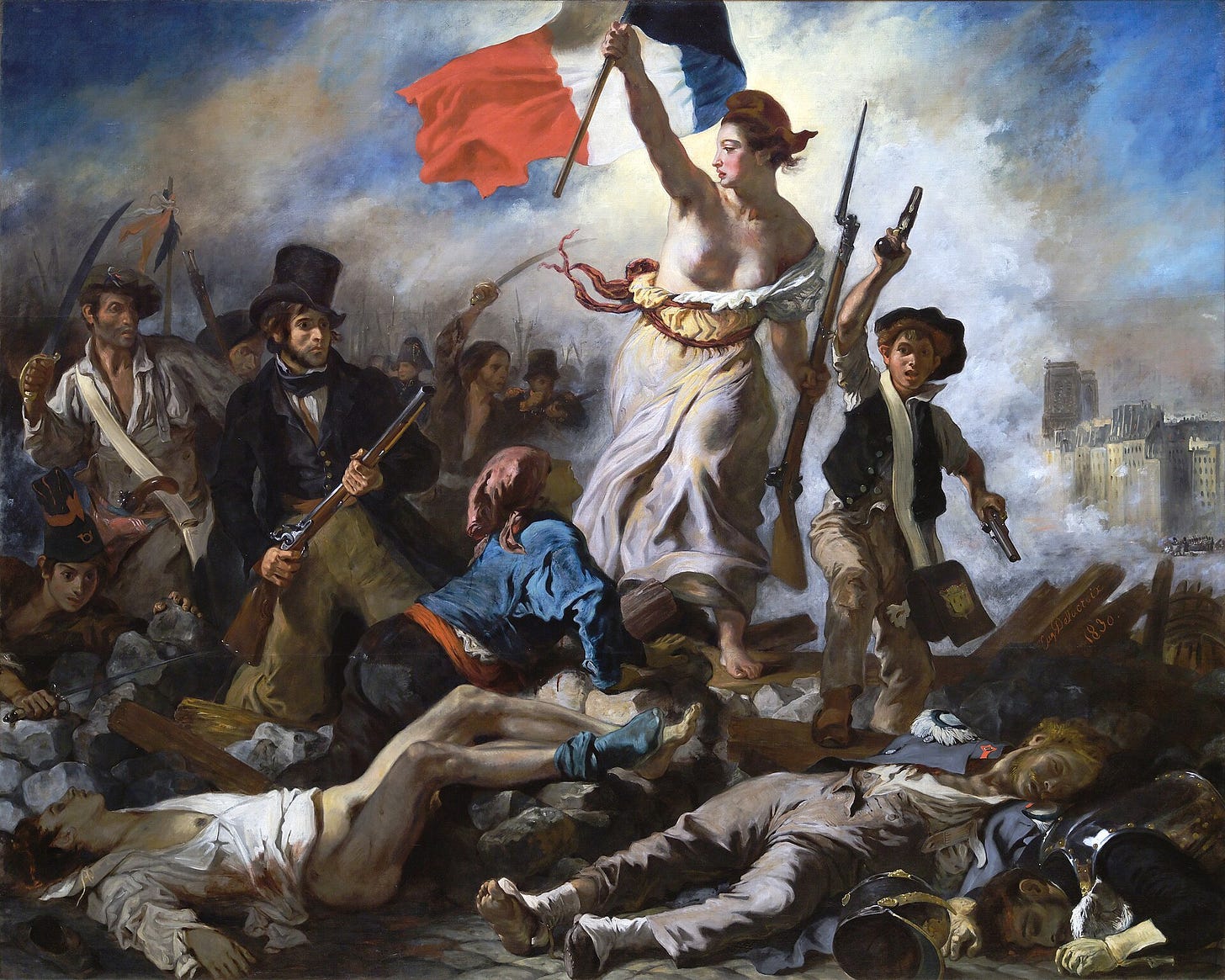The nudity of Liberty Leading the People
What Delacroix’s bare-breasted Liberty reveals—and why we still need her
She charges through the smoke of revolution, a tricolor flag in one hand and a musket in the other. Around her, the fallen lie in heaps—some with uniforms, others without pants. Her dress is torn, her feet are bare, and her chest is exposed. In Liberty Leading the People, Eugène Delacroix painted not a queen, not a goddess, but a figure made of grit and breath and blood. And he painted her partially nude.
That exposed breast has never been incidental. It wasn’t painted to titillate, nor to idealize. It was painted to say something that the artist, perhaps, could not: that liberty requires us to strip away illusion, and that freedom—true freedom—is not a polite or clothed affair.
Delacroix began the painting in the fall of 1830, just weeks after the July Revolution. On July 26, King Charles X had issued a series of authoritarian ordinances that dissolved the elected Chamber of Deputies, censored the press, and restricted voting rights. Paris erupted. For three days, barricades filled the streets, and protesters fought royal soldiers block by block. Charles fled to England. The crown passed to Louis-Philippe, styled the “Citizen King,” and the Second French Revolution ended with a compromise: a monarchy restrained by constitutional law, yet still a monarchy.
Delacroix, not a fighter, still felt compelled to respond. “My bad mood is vanishing thanks to hard work,” he wrote in a letter that October. “I’ve embarked on a modern subject—a barricade. And if I haven’t fought for my country, at least I’ll paint for her.”1
The image Delacroix created is unforgettable. Liberty is right there in the middle of it—barefoot, bare-chested, and human. She feels less like a symbol and more like someone who might’ve actually been on the barricades. There’s a lot to take in, but the nudity draws your attention and holds it.
While Delacroix’s Liberty is an obvious allegory, her nudity is not symbolic in the usual way. It doesn’t gesture toward virtue or idealism. It doesn’t elevate her above the scene. If anything, it pulls her down into it. She wasn’t drawn from mythology, but from the street. She was, as one critic later noted, “taken from contemporary life that did not hark back to classical mythology”; not a figure of inherited ideals but one forged in the smoke of revolt.2 Her chest is bare because there’s no protection here—not from bullets, not from history, not from the weight of what’s coming.
This was a painting born from upheaval. And yet, it didn’t emerge as propaganda. Delacroix didn’t paint a banner or a leader or a martyr. He painted the people, and he gave them a body to follow. Not a uniform. Not a crown. A body.
That choice—painting liberty as exposed, human, and armed—was radical enough that the painting had to be hidden away (ordered so by the next king). For nearly two decades, it was considered too dangerous to hang in public. But it survived. And over time, it became something else: a national image, a myth, a reference point. In the words of Artsper Magazine, Liberty became both “the mother country that protects and the warrior ready to defend her country.”3
This isn’t a fantasy of peace. It’s a portrait of rupture. This painting doesn’t celebrate violence. It points to something more unsettling: the urgency to act when power won’t yield. The people in this painting are not waiting for permission. They’re not passing laws or giving speeches. They’re moving—together, urgently, and with everything they have. They are forcing a turning point with their hands, their blood, and their bodies in full view.
There are no kings in this painting. There is no pomp. No generals or saviors. Just the people—and the one who leads them, her chest bare, her hand raised, her voice silent but unmistakable. She is not clothed in glory. She is naked in truth. She is Liberty. 🪐
Delacroix, E. (1830, October 21). Letter to his brother. As cited in Liberty Leading the People, Wikipedia. https://en.wikipedia.org/wiki/Liberty_Leading_the_People
Paliyenko, A. M. (2023). Liberty Leading the People by Delacroix. EBSCO Research Starters. Retrieved from https://www.ebsco.com/research-starters/visual-arts/liberty-leading-people-delacroix
Artsper Magazine. (2023). The image of the French Revolution. https://blog.artsper.com/en/a-closer-look/french-revolution-images/




Long live simple & naturally naked freedom.
No kings! Excellent and timely piece.